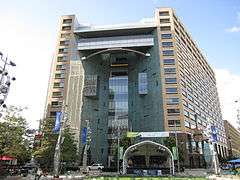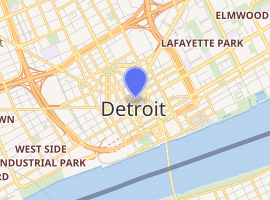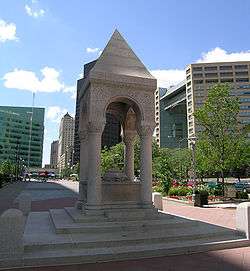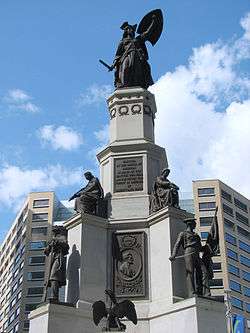One Campus Martius
One Campus Martius is a building located in downtown Detroit, Michigan. It began construction in 2000 and was finished in 2003. It has seventeen floors in total, fifteen above-ground, and two below-ground, and has 1,088,000 square feet (100,000 m2) of office space. The high-rise was built as an office building with a restaurant, retail units, space for Compuware and a fitness center, as well as an atrium. The building now has Quicken Loans, Microsoft, Meridian Health, Plante Moran and Compuware as its major tenants.
| One Campus Martius | |
|---|---|
 | |

| |
| General information | |
| Type | office |
| Location | 1050 Woodward Ave Detroit, Michigan, U.S. |
| Coordinates | 42.3327°N 83.0464°W |
| Construction started | 2000 |
| Completed | 2003 |
| Height | |
| Roof | 232 ft (71 m) |
| Top floor | 216 ft (66 m) |
| Technical details | |
| Floor count | 15 (+2 underground) |
| Floor area | 1,088,000 square feet (100,000 m2) |
| Lifts/elevators | 24 |
| Design and construction | |
| Architect | Rossetti Associates, Hamilton Anderson Associates, WET Design |
The building was constructed in the late-modernist architectural style, using glass, granite and limestone as its main materials. AIA Detroit's Urban Priorities Committee rated the building's entry as one of the top ten Detroit interiors.[1]
History
The building sits on the Kern Block which was once home to the Kern Department store. The store had existed in some form or another on this site since 1900. The last incarnation of the store was demolished in 1966, and the area remained greenspace until 1999 when Campus Martius Park began to take shape. Compuware moved its headquarters and 4,000 employees to a newly constructed building on the site in 2003. Quicken Loans agreed to a five-year lease agreement to move its headquarters and 1,700 employees to the building in 2010.[2] Plante Moran followed suit with a lease agreement in 2013, deciding to move 75 employees to the building.[3]
Compuware's presence in the building has lessened as it has downsized during the 2010s the company now has around 800 employees in the building. The building was sold in a joint venture to Dan Gilbert's real estate group Bedrock Real Estate and Meridian Health for $142 Million in November 2014. As part of the deal Quicken Loans took an additional floor bringing its space in the building to 300,000 sq. ft. Meridian moved 700 team members into the building in spring 2015 with 1700 employees expected by the end of the year.[4][5] Compuware's remaining employees will stay in the building.
Description
The headquarters facility, completed in 2002, has 16 floors and 1,088,000 square feet (101,100 m2) of space. The headquarters facility includes an on-site daycare, a 38,000 square feet (3,500 m2) fitness center, and 55,000 square feet (5,100 m2) of retail space.[6] The lobby contains what is said to be the world's tallest indoor water sculpture.
One Campus Martius Garage
- This 3,000-space parking structure stands 45-meter tall with 12-stories (2 underground floors).
- This parking structure includes over 20,600 square feet (1,910 m2) of retail and office space on its first floor, and a 2,891-square-foot (269 m2) daycare center on its second level.
- The One Campus Martius Garage is home to the Cadillac Center Station on the Detroit People Mover route.
Gallery
 Compuware World Headquarters with Michigan Soldiers' and Sailors' Monument and Woodward Fountain
Compuware World Headquarters with Michigan Soldiers' and Sailors' Monument and Woodward Fountain Right outside entrance, looking upwards
Right outside entrance, looking upwards.jpg) Atrium waterfall
Atrium waterfall Atruim waterfall by elevators
Atruim waterfall by elevators Light enters from above to illuminate hanging glass sculpture
Light enters from above to illuminate hanging glass sculpture Interior glass looks on to atrium
Interior glass looks on to atrium Hard Rock Cafe sign on the outside of Compuware World Headquarters for the park
Hard Rock Cafe sign on the outside of Compuware World Headquarters for the park Compuware World Headquarters near Cadillac Square
Compuware World Headquarters near Cadillac Square Compuware World Headquarters facing the Michigan Soldiers' and Sailors' Monument
Compuware World Headquarters facing the Michigan Soldiers' and Sailors' Monument
References
- AIA Detroit Urban Priorities Committee, (1-10-2006).Top Ten Detroit InteriorsModel D Media
- Quicken Loans to Move Headquarters, 1,700 Employees to Downtown (7-13-2009).Quicken Loans
- Plante Moran to open Detroit office in the Compuware building (6-6-2013).Plante Moran
- "Gilbert's Bedrock, Meridian Health to buy Compuware building in Detroit". Crain's Detroit Business. November 17, 2014.
- "Meridian Health plans move to Compuware building". Crain's Detroit Business.
- "Corporate Headquarters." Compuware. Retrieved on January 7, 2010.
Further reading
- Sharoff, Robert (2005). American City: Detroit Architecture. Wayne State University Press. ISBN 0-8143-3270-6.
External links
| Wikimedia Commons has media related to Compuware Headquarters. |
- One Campus Campus Martius - Bedrock Real Estate Services
- Downtown Detroit photo gallery
- Compuware official website
- One Campus Martius at Emporis
- Compuware Garage at Emporis
- Compuware Headquarters Complex at Emporis
- "Compuware World Headquarters". SkyscraperPage.
- Google Maps location of Compuware World Headquarters
- Construction footage from 2002
.svg.png)